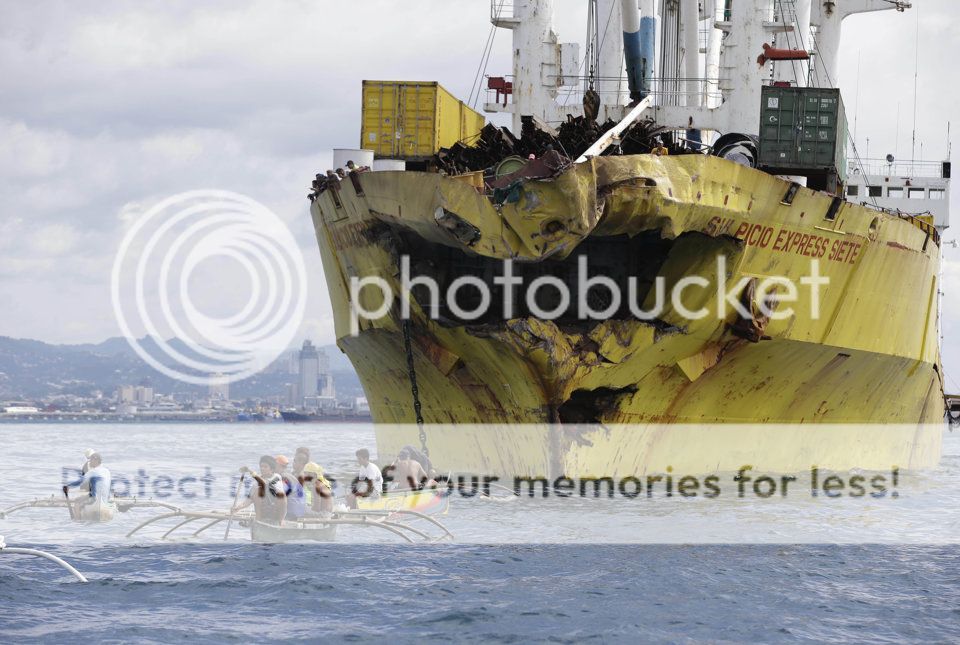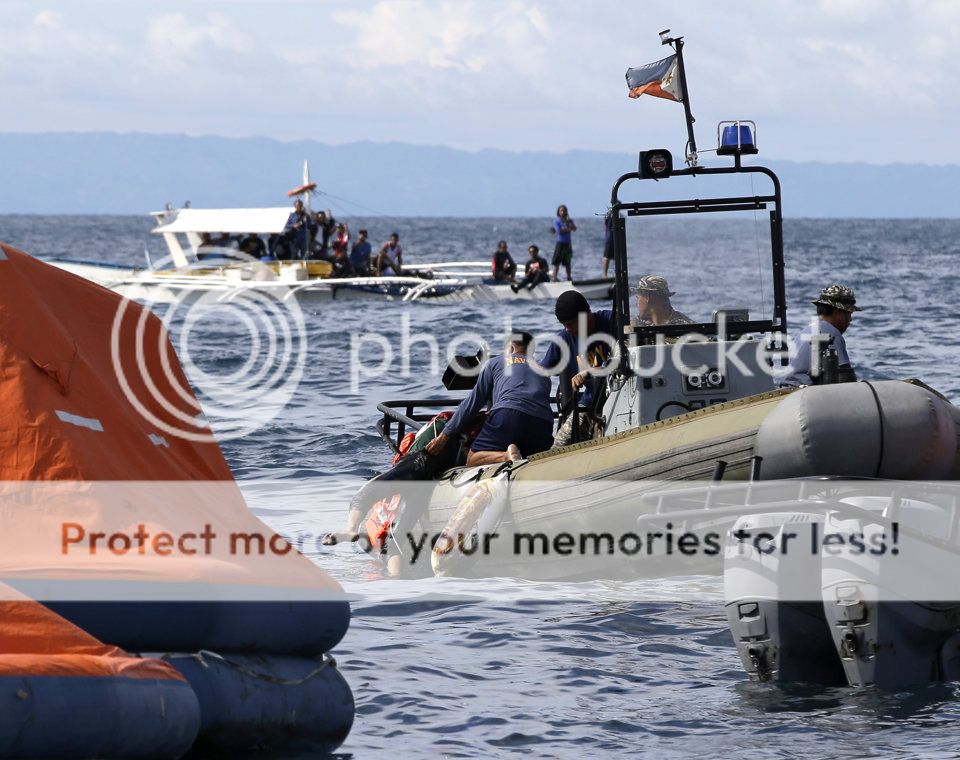The lack of Vessel Traffic Management System and missing Bouys marking the Cebu Harbor Traffic Separation Scheme is the major factor in recent Cebu Collision between the cargo vessel " MV Sulpicio Express Siete" and the passenger vessel "MV Saint Thomas Aquinas".
How two large ships could collide at sea in fine weather less than hour from Cebu City harbor will be the focus of investigation of Friday's mishap that left 32 dead and sank the MV St. Thomas Aquinas of 2GO Shipping. A search continues for 58 missing persons after 751 passengers and crew were rescued.
With both vessels following the same route near Lawis Ledge off Talisay, what happened to radio communication between them? The answers will be crucial in the investigation of the Maritime Industry Authority (Marina) which yesterday suspended operations of the entire fleet of both 2GO Shipping and the Philippine Span Asia Carrier Corp. formerly known as Sulipicio Lines pending an inspection of its vessels and compliance with safety standards.
"Like any other accidents, the ship collision last Friday could have been avoided," said Commodore William Melad,district commander for the Philippine Coast Guard Central Viasyas in an interview. He said rescue operations would continue: "We're not losing hope. Sometimes, miracles happen." "As our protocol, we follow the International Regulation for Prevention of Collision which governs the movement of sea vessels. When two ships are about to meet each other on the same path, they should give way. But I'm not saying that the two ships didn't communicate with each other last Friday."
The MV Sulpicio Express Siete, a cargo ship, with its bow badly damaged was towed to the Cebu city port yesterday. Some of the missing are believed trapped inside the St. Thomas Aquinas, a ro-ro vessel that sank about 100 feet deep off Lawis Ledge in Talisay City. "There could be more bodies there, but there were ropes inside that our divers could get entangled in," PCG deputy chief Rear Admiral Luis Tuason, vice commandant of the coast guard, said. "It did not take long, about 10 minutes, before the ferry sank," Tuason said. "The captain managed to declare abandon ship and they distributed life jackets but, because of the speed by which it went down, there is a big chance that there are people trapped inside." The captain of the ferry MV Thomas Aquinas, which was approaching the port about 9 p.m. Friday, gave the order to abandon ship when it began listing and then sank just minutes after collision with the MV Sulpicio Express Siete, he said. The captain was eventually rescued. He was taken to the Sugbutel in the North Reclamation Area where other surivors are being billeted by the 2GO management.
http://cebudailynews.ph/news/story/18843/freak-collision-to-be-investigated
The collision happened near Lauis Ledge light beacon.
The cargo vessel "Sulpicio Express Siete" followed the wrong lane which is for INBOUND Traffic,
she should navigate the OUTBOUND lane which is located on the west side of the Cebu-Mactan Traffic Separation Scheme.
she should navigate the OUTBOUND lane which is located on the west side of the Cebu-Mactan Traffic Separation Scheme
The passenger vessel Saint Thomas Aquinas's alteration of course to Port side is a wrong decisions since it contravened the Collision regulations, it is okey if they have positive VHF Radio communications with the cargo vessel Sulpicio Express Siete. As per some news reports they don't agree with each other a few minutes before the collisions, nobody wants to give way.
The cargo vessel Sulpicio Express Siete should alter to her starboard side so that she can go to her
correct Outbound lane.
Not possible for the Passenger vessel "Saint Thomas Aquinas" to alter her course to starboard side since she will aground in the shallow water off Lauis Ledge light beacon. She could stop her Main Engine to prevent collision rather .than alter her course to port side which is a contravention of the collision regulations since it will confuse the other vessel of her intention. Owing to currents in that place, if her vessel is stopped in the water, she could be drifted to shallow water but it will be preferable than having a collision with a vessel like Sulpicio Express Siete who don't follow the TSS rules. Drifting in the shallow water off Lauis Ledge will not damage her hull since her Main Engine is stopped. I just received an information from a Skyscraper City Forum that MV Saint Thomas Aquinas's VHF Radio was set to Channel 12 instead of Channel 16 which is the calling and Distress frequency.
Please read also the below Forum:
http://www.skyscrapercity.com/showthread.php?t=1354135&page=144
http://www.timawa.net/forum/index.php?topic=35611.msg363907#new
************************************************************************
The majorcontributing factor in the recent collision is the absence of navigational bouys that marked the Traffic Separation Scheme are and also the absence of a light beacon to mark the shallow water in the vicinity of Narvaez Reef and Lipata Bank which is located near the southwest end of the Cebu-Mactan Traffic Separation Scheme. Because of this situation most vessels especially domestic vessels ignored theTSS and they navigate away from the shallow water of Narvaez Reef and Lipata Bank (located near the vicinity of the southwest end of VTSS) which has no light beacon nor bouys. So the outbound vessels also used the INBOUND lane of the Traffic Separation Scheme till Lauis Ledge, so maritime disaster shall happen because of this situation.
The other contributing factor in the recent ship's collision off Lauis Ledge light beacon is the absence of a Port Control or Vessel Traffic Management System in Cebu Harbour which include the Lauis Ledge and the shallow water of Narvaez Reef and Lipata Bank located in the southeast end of the Traffic Separation Scheme. No authority is monitoring or controlling the movement of vessels in the Cebu Harbor TSS, so most domestic vessels where navigating / using the Inbound lane whether Inbound or Outbound vessels.
The port of Cebu is one of the most important shipping centers in the Philippines being second only to Manila and yet no Port Control or a Vessel Traffic Management System to monitor and control the maritime traffic coming in and out of Cebu-Mactan Traffic Separation Scheme.
* * * * * * * * * * * * * * * * * * * * * * * * * * * *
A vessel traffic service (VTS) is a marine traffic monitoring system established by harbour or port authorities, similar to air traffic control for aircraft. Typical VTS systems use radar, closed-circuit television (CCTV), VHF radiotelephony and (AIS) automatic identification system to keep track of vessel movements and provide navigational safety in a limited geographical area.
A service implemented by a competent authority, VTS is designed to improve the safety and efficiency of navigation, safety of life at sea and the protection of the marine environment. VTS is governed by SOLAS Chapter V Regulation 12 together with the Guidelines for Vessel Traffic Services [IMO Resolution A.857(20)] adopted by the International Maritime Organization on 27 November 1997.
http://en.wikipedia.org/wiki/Vessel_traffic_service
and controlled by Corregidor VTMS and Manila VTMS. The approximate boundary or jurisdiction of Corregidor VTMS and Manila VTMS in in-line with San Nicolas Shoal of Manila Bay.
A (VTMS) Vessel Traffic Management System is in place in Subic Bay Freeport, Corregidor island, the Port of Manila, and the Batangas-Verde Island Passage Area.
Manila VTMS
Batangas-Verde Island Passage VTMS
There is no (VTMS) Vessel Traffic Management System in the Port of Cebu which is a very busy port second to Manila, except for a Pilot Station for foreign-going vessel.
To prevent the occurence of another maritime disaster in the Port of Cebu City involving domestic Passenger vessels, a Vessel Traffic Management System must be established to monitor and control the busy Cebu-Mactan Vessel Traffic Separation Scheme were many vessels were ignoring as if it never exist.
Youtube Videos
Youtube Videos
Philippine Ferries collide



















No comments:
Post a Comment